Catalina wrote:Anyone have a explanation for the very well-defined, tightly convoluted, squiggly lines going across the front of NGC 6559? They are like dust lanes I have never seen.
Here is my
amateur interpretation of what we are seeing. Be warned.
First of all, we need to see several images of this area to get a better understanding of the objects there. So here goes:
NGC 6559. Photo: Adam Block.
NGC 6559. Credit and copyright: Jean-Charles Cuillandre.
Take a look at these two pictures of NGC 6559. The way I understand it, NGC 6559 is the bright red arc-shaped emission nebula which is centrally placed in Jean-Charles Cuillandre's image. It's to the lower left in Adam Block's image. To the upper left of NGC 6559 in Jean-Charles Cuillandre's image, and to the upper right of of NGC 6559 in Adam Block's image, is a bright blue star which is tangled in convoluted dust lanes. This star is HD 165921.
According to Simbad Astronomical Database, HD 165921 is a binary star consisting of O7V and B0V components.
So HD 165921 is a powerful star, which emits a lot of ultraviolet light. Even so, the red emission nebula that surrounds it is faint. My interpretation is that the stellar wind of HD 165921 has blown away much of the gas from the star's vicinity, so that there is relatively little gas there to ionize. Other powerful stars have done much the same thing: Check out
this image of Orion and note the relative faintness of the Lambda Orionis nebula at Orion's "head".
But even though I believe that HD 165921 is located in an area where the "gas density" is low, I also believe that the dusty tendrils surrounding it (looking impressively blue in Jean-Charles Cuillandre's image) are dusty remnants of the gas cloud that HD 156921 were born from. Or... no. No, it's more likely that the tendrils of dust were produced much later, during some violent event involving one or both stars of HD 1565921 itself. Maybe the two components had a too-close encounter of the third kind? Maybe one of the stars ate one of its large planets, totally shattering it and spreading dust along its tattered magnetic lines?
Note the rectangular area of relative emptiness surrounding HD 165921, as if the bright binary star had blown out a "
Spongebob Squarepants" cavity around itself. But the walls of this cavity are relatively smooth and regular, belying any truly violent event. Then again - those contorted dust lanes look "battle-scarred"!
NGC 2327. Photo: Catman46.
Fascinatingly, there is one convoluted string of dust that seems to connect HD 165921 with NGC 5965. Is it even possible that the connection is "real"? Could it be, is it possible, that HD 165921 and NGC 6559 are two different products of more or less the same dusty gas cloud? And could it be that the "umbilical cord" between them is the only connection that remains? Other nebulas also have dusty cords seemingly attached to them. Look at NGC 2327, the "head" of the Seagull Nebula, and the umbilical dust cord hangin out from the Seagull's "eye", HD 53367.
So where did the bright red arc-shaped nebula NGC 6559 come from?
Well, as you can see, the red arc of NGC 5965 seems to almost "embrace" a blue reflection nebula "below" (or "behind") it. There are two whitish stars plainly visible in the blue reflection nebula, as well as a lot of dust. In Jean-Charles Cuillandre's image you can see how the red emission nebula actually seems to encircle the blue reflection nebula in its entirety.
I believe that the blue reflection nebula is a site of ongoing star formation, so that the stars inside are very young. I would think that there are still more stars being born in there, perhaps behind the thick dust that can be seen to one side of the blue reflection nebula.
A region of star formation that is mostly blue in color means, to me, that the stars born here are of relatively low mass. There are no O-type stars here, and probably no very early B-type stars, either. Nevertheless, star formation is an energetic process. The combined heat, ultraviolet light, X-rays and other forms of energy produced by these young stars will push at the dust cloud that they were born from. So the dust cloud tries to expand. But as it does so, it runs into the strong wind and harsh ultraviolet light emitted by HD 165921, the O7V+B0V binary star.
In other words, I think that the bright red arc of NGC 5965 is a place where hydrogen is being piled up because it is pushed at from two directions, and it is becoming ionized by energetic processes working at it from both northwest and southeast.
IC 1274-1275. Photo: R Jay GaBany.
Now let's look at another fascinating object here, an emission nebula known as IC 1274. I believe that IC 1274 is the round pink nebula at far left in R Jay GaBany's image. There are a couple of blue stars inside it, and it seems to be surrounded by a blue "border". As you can see, there are a couple of dark dust towers in front of it, and to me it seems obvious that this dust is being evaporated away. The dusty wall connecting the two dark towers is smoking like a chimney! The stars doing the dust evaporation and providing the blue illumination are most likely the stars of IC 1274, or so I think anyway.
Well, those are my two cents! There is certainly a lot of dust and gas in this area, and different groups of young stars are affecting the dust and gas in different ways.
Ann
 A Sagittarius Triplet
A Sagittarius Triplet



